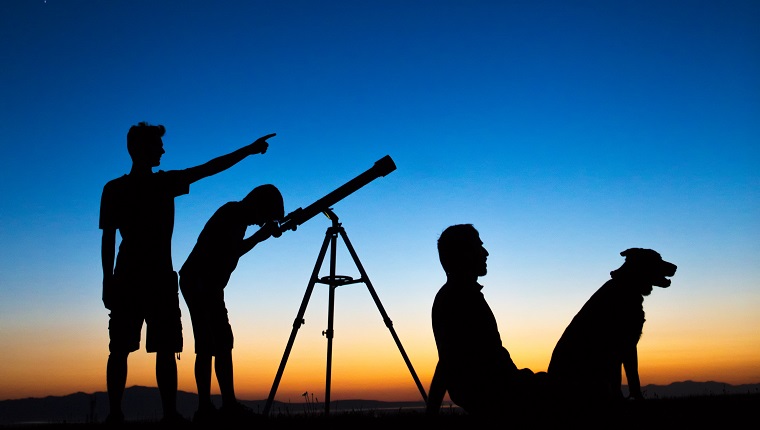For thousands of years, the night sky has provided humans with direction, a sense of wonder, and sometimes even feelings of comfort in the form of familiar points of light that act as constant, trustworthy companions. The stars are a lot like our dogs in that way. They’re dependable and helpful, and they can guide us when we need them.
It’s no wonder that even ancient astronomers saw the familiar shapes of our canine friends in the sky.
Even modern astronomers name what they see after the dogs from our legends and myths. And don’t forget, a dog named Laika left this planet before any human did, becoming the first animal to orbit the Earth.
As long as people keep looking up, they’ll keep naming what they see after dogs to make the cold, beautiful emptiness of our universe feel a little more friendly. Here are some of the objects in astronomy that carry dog names.
What Are Hot DOGs?
If you’re not much of an astrophile, you may have never heard of Hot DOGs. They’re not named after the food in a bun that you buy at a baseball game, and in fact, they’re not even named after dogs.
Hot DOG, in terms of astronomy, stands for Hot Dust-Obscured Galaxy.
These galaxies are aptly named, and it’s probably for the best that they aren’t really named after dogs because they seem rather unfriendly.
First of all, they’re hot — about 1,000 times hotter than our Milky Way galaxy. They also can’t be seen with ordinary telescopes, as the dust that surrounds them obscures any light that our human eyes might detect from them.
They do, however, dump out enormous amounts of light in infrared wavelengths.
Hot DOGs mostly formed about ten billion years ago when the universe was still relatively young, and scientists hope that they will help provide insights into what the universe was like back then.
The galaxies may have been formed by highly active, supermassive black holes, which could explain why they’re so bright and hot.
At any rate, you’re probably much safer in our home galaxy with your own hot dog who will probably cool off with some shade and water.
Dog Constellations: Canis Major
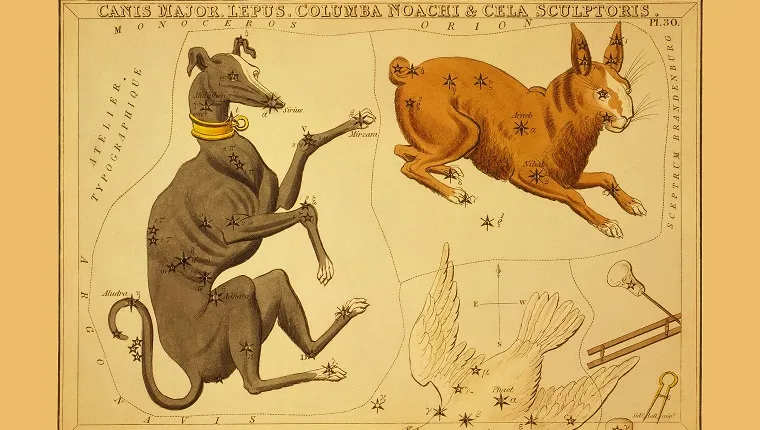
There are three major modern constellations that carry the names of dogs, and the most famous of these is Canis Major, which means the Greater Dog.
The ancient Greeks recognized this constellation as a representation of dogs from their mythology. Some thought of it as the dog Laelaps, who was a gift from Zeus to the demi-goddess Europa. Others thought it was the hound of Procris, a dog who could catch anything he hunted. And others thought of it as the companion of the hero Cephalus, a dog so fast that Zeus put him in the sky.
The constellation was also considered to represent one of the hunting dogs of Orion, and early star maps showed him hunting the hare under Orion’s feet or helping to fight Taurus, the bull constellation.
Romans continued to think of the constellation as representative of the dogs in their mythology, as well.
Dog Constellations: Canis Minor

Canis Minor is the other well-known dog constellation, and its name means the Lesser Dog.
The Greeks sometimes identified it as the Teumessian Fox, a creature that was hunted by the dog Laelaps and turned to stone by Zeus. Some identified it as the hunting dog of Orion, and others called it Maera, the dog that belonged to Icarus.
Ancient Egyptians thought of the constellation as representing Anubis, the jackal-headed god. So the Greeks weren’t the only civilization to associate this constellation with canine forms.
Dog Constellations: Canes Venatici
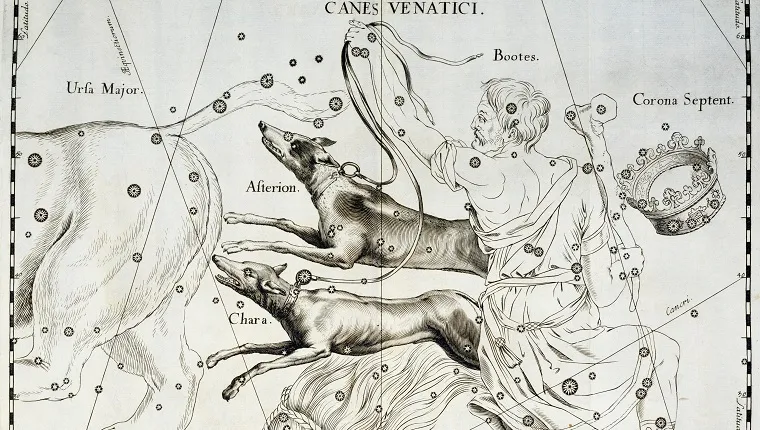
The dog constellation you may not have heard of is Canes Venatici, which represents Boötes, the Herdsman, and his two hunting dogs, Asterion and Chara, as they hunt the Great Bear, which you may know as the Big Dipper.
Looking at the constellation, you may think that it doesn’t look like there are any dogs — and you may be right.
The original story associated with the constellation referred to Boötes’s club, not his dogs. Though through a series of mistranslations, the club came to be seen as two dogs held by leashes. Now, that’s how they are always represented.
It’s for the best, as we’re always happy to see more pups in the sky.
The Dog Stars

The dog stars are located in the dog constellations, and they were very important to early civilizations.
Procyon is the brightest star in the constellation Canis Minor, and the name translates to “before the dog.” It was called this because it appeared in the sky before Sirius, the dog star that rose during summer.
Procyon’s appearance let ancient people know that the hottest summer weather would probably arrive within about two weeks. It is also referred to as the “little dog star.”

Sirius is the brightest star in the Canis Major constellation and the fifth brightest in the sky.
The name Sirius translates to “glowing” or “scorcher” in Ancient Greek. That’s appropriate, as its appearance often indicated the arrival of the hottest days of the year.
In fact, some believed Sirius and Procyon were warming the Earth with their light. Some people thought that’s what caused the days to be so hot.
These hot days may have led to dogs behaving erratically, panting to cool off, and sometimes appearing rabid. That further cemented the connection of the stars with dogs.
The hot days under the dog stars are where we get the term “dog days of summer.”
Sirius wasn’t just associated with canines in ancient Greece. It was known as the “celestial wolf” in Chinese astronomy, and many Native American tribes referred to it as a dog, a wolf, or a coyote.
Sirius and Procyon are still represented as dog stars in modern times. They were significant stars for many people around the world. Therefore, it’s no wonder they were — and still are — associated with our furry best friends.
The Asteroid And The Moon
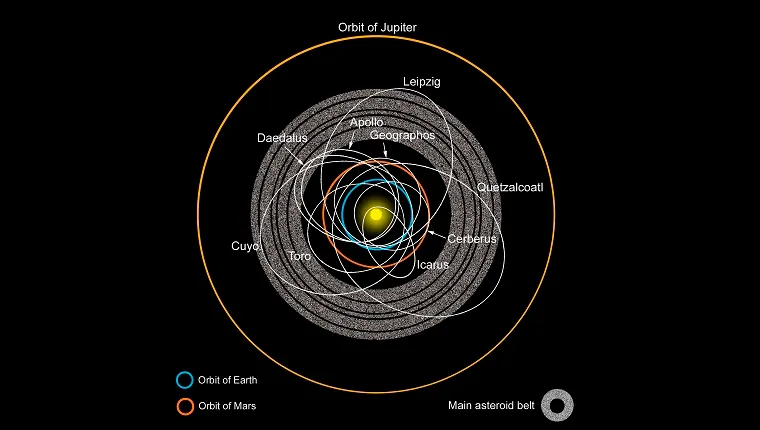
In keeping with the tradition of naming objects in the sky after both dogs and characters from mythology, there are two celestial bodies named after Cerberus, the three-headed dog who guarded the entrance to the underworld in Greek legends.
The first object is an asteroid that orbits the sun at a distance close enough to our planet for it to be called a “near-Earth object.” It was discovered in 1971, by a Czech astronomer named Luboš Kohoutek, and its official name is 1865 Cerberus.
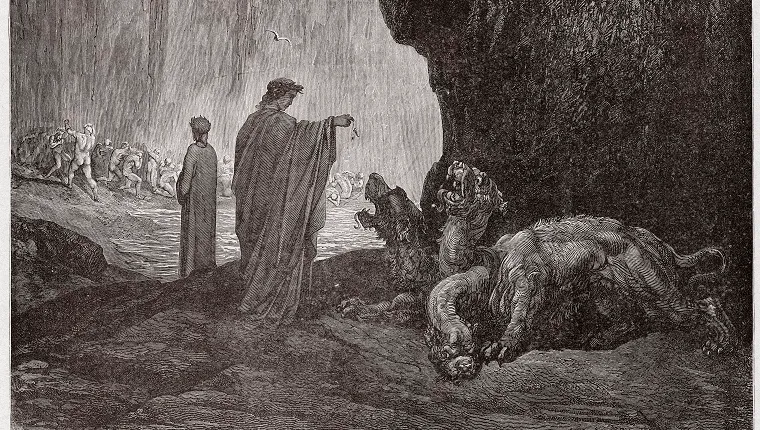
The other object that shares its name is Kerberos, which is the Greek spelling of Cerberus.
It’s the fourth moon of Pluto to be discovered. Pluto is the name of the god of the underworld, and the moons of Pluto have names associated with him.
The moon was almost named after Romulus, the founder of Rome who is linked with wolves in mythology. However, an asteroid already had that name. The spelling of Kerberos had to be changed so it wouldn’t be confused with 1865 Cerberus.
Neither of these should be mistaken for the ancient constellation Cerberus, which has since been incorporated into the constellation Hercules, named for the mythological Greek hero. The old Cerberus constellation is now depicted as part of an apple branch held by the hero.
So, unfortunately we lost a dog constellation, but we gained two cool objects that carry on the name.
Do you know of any other celestial bodies named after dogs? Do you ever see the shapes of dogs in the night sky? Let us know in the comments below!
